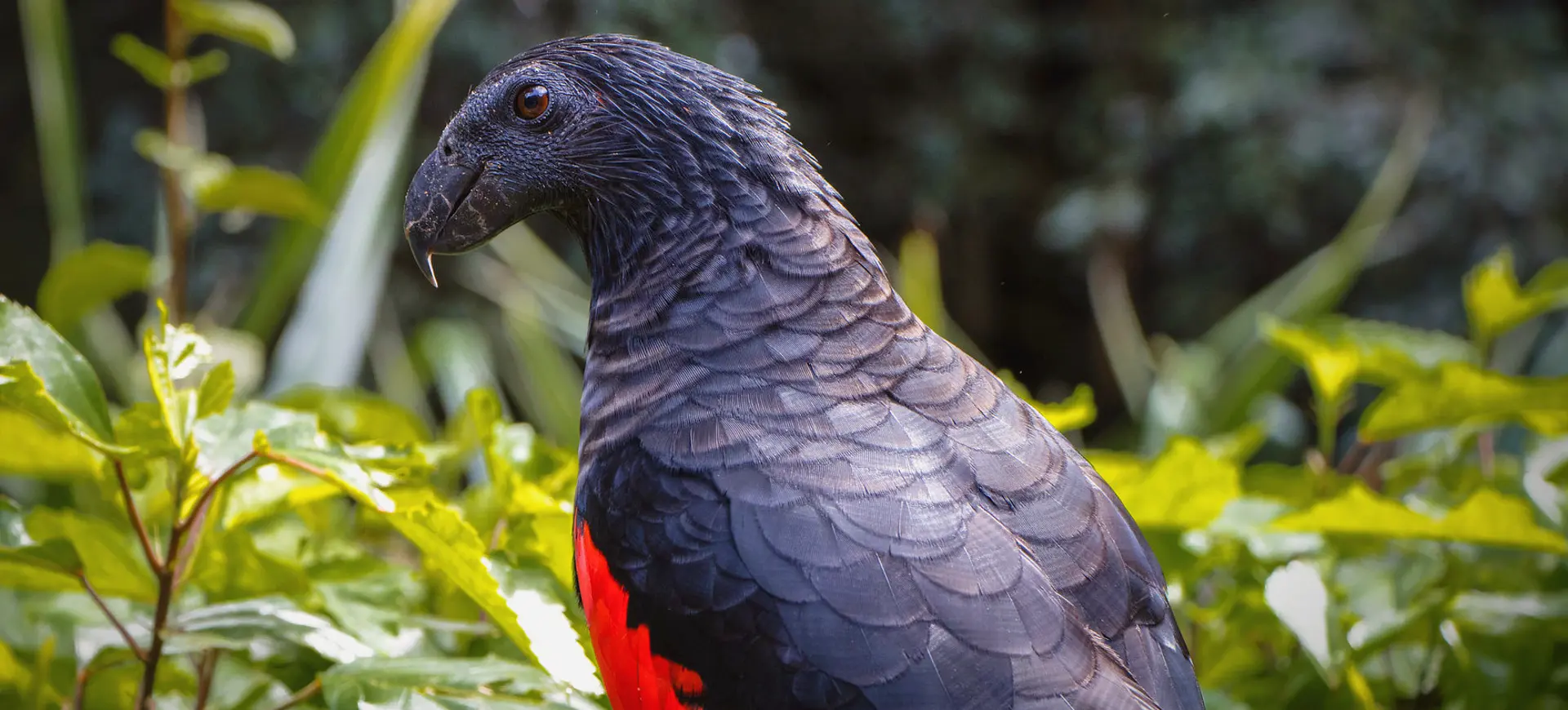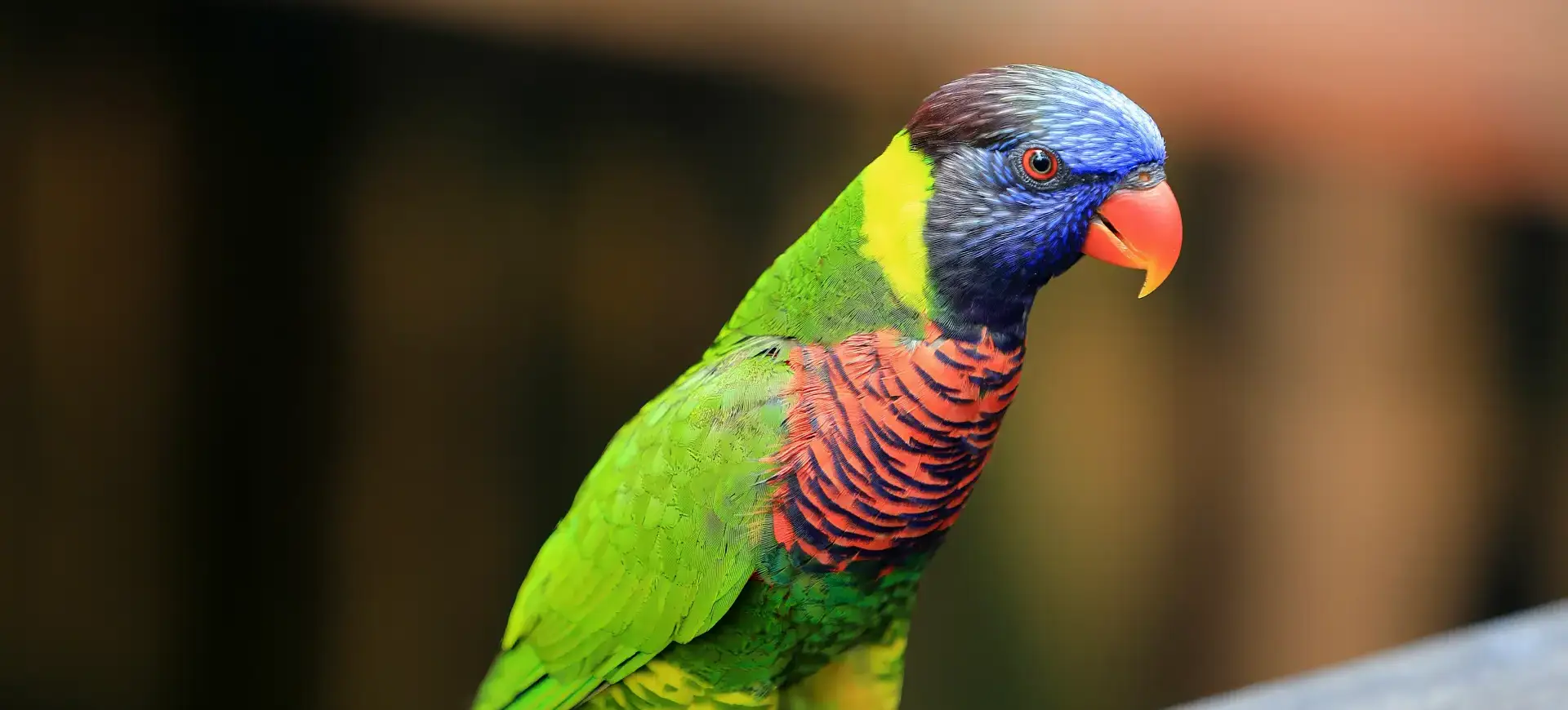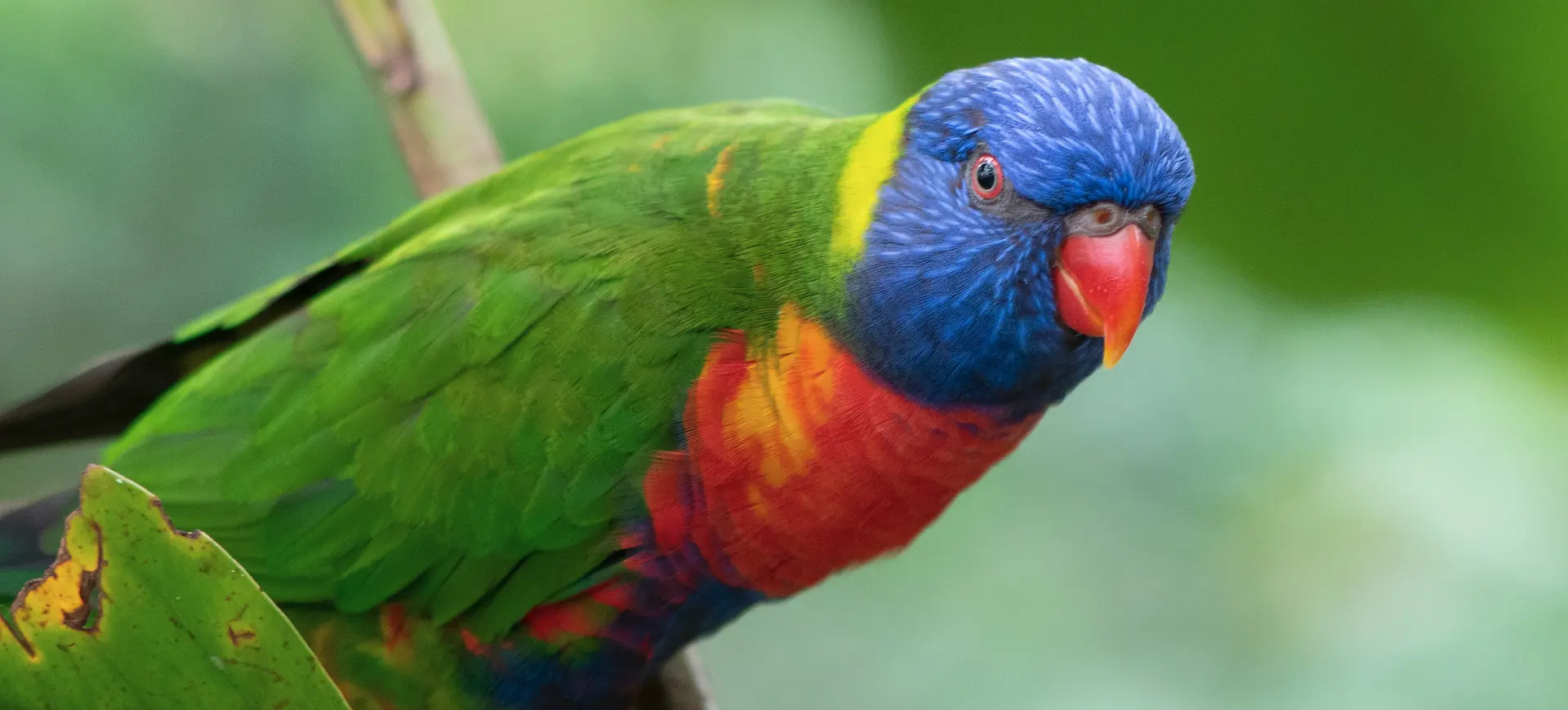Overview
The Moluccan Eclectus, or the Eclectus Parrot (Eclectus roratus), is a strikingly vibrant bird known for its extreme sexual dimorphism, where males and females exhibit markedly different coloration. Native to the Moluccas (Maluku Islands) in Indonesia, this bird has captivated avian enthusiasts with its beauty and intelligence. Males are primarily bright green with varying amounts of red and blue on their wings and tails, while females are predominantly red with a blue belly and underwing. This distinctive coloration difference once confused scientists that males and females were considered separate species.
Eclectus Parrots are known for their calm and generous nature, making them highly sought after as pets. They possess a strong ability to mimic human speech and sounds, which, combined with their social behavior, creates a deep bond between them and their owners. In the wild, these parrots inhabit tropical rainforests, where they can be found in the canopy, feeding on fruits, nuts, seeds, and berries. The Moluccan Eclectus plays a vital role in its ecosystem as a seed disperser, contributing to the health and regeneration of the forest.
The breeding behavior of the Moluccan Eclectus is unique, with females often being more dominant and territorial. They nest in tree cavities, where the female remains to guard the nest and care for the eggs, relying on the male to bring her food. Like other Eclectus Parrots, this subspecies exhibits cooperative breeding behavior, where offspring from previous clutches may assist in raising the young. Conserving their natural habitat is crucial for maintaining healthy populations in the wild, as habitat loss and capture for the pet trade pose significant threats to their survival.
Taxonomy
Kingdom
Phylum
Class
Order
Family
Genus
Species
Type
Physical Description:
The Moluccan Eclectus is renowned for its brilliant plumage, with the male showcasing a bright emerald green body contrasted by red underwing coverts and blue primary flight feathers. The female’s appearance is striking, with a deep red body, blue belly, underwing coverts, and a purple-blue band on the nape. Both sexes have a distinctive orange beak, although the females tend to be darker, almost red. This sexual dimorphism is most pronounced in the bird world and serves various ecological and social functions.
Adult Moluccan Eclectus Parrots are medium-sized, typically reaching lengths of up to 14 inches (35 cm) from beak to tail. Their robust and somewhat stocky build is complemented by a broad tail and wings, which facilitate agile flight in the dense rainforest canopy. The bright colors serve as a mating attractant and act as camouflage among the vivid foliage and fruits of their habitat. The eyes of the Eclectus are bright and expressive, with the males typically having yellow-irises and the females, a more reddish hue.

Lifespan: Wild: ~30 Years || Captivity: ~40 Years

Weight: Male & Female: 14-17.5 ounces (400-500 g)

Length: Male & Female: 12-14 inches (30-35 cm)

Wingspan: Male & Female: 8-10 inches (20-25 cm)

Top Speed: 40 mph (64 km/h)
Characteristic:
Native Habitat:
The Moluccan Eclectus inhabits the tropical rainforests of the Moluccas or Maluku Islands in Indonesia. These islands offer a lush, biodiverse habitat with abundant food sources and nesting sites. These rainforests’ dense canopy and high humidity provide an ideal environment for the Moluccan Eclectus, supporting their frugivorous diet and nesting preferences.
Their habitat preference includes primary and secondary forests found in the canopy and forest edges. The preservation of these habitats is crucial for the survival of the Moluccan Eclectus, as deforestation and habitat degradation pose significant threats to their populations.
Climate Zones:
Biogeographical Realms:
Continents:
Countries:
Diet:
Diet & Feeding Habits:
Moluccan Eclectus Parrots have a primarily frugivorous diet, feeding on a wide variety of fruits, berries, nuts, flowers, and leaf buds. This diet is rich in water and fiber but low in fat, reflecting their natural feeding habits in the wild. The birds possess a unique digestive system that efficiently extracts nutrients from such a diet, contributing to their vibrant plumage.
In captivity, their diet must be carefully managed to replicate the nutritional diversity of their natural food sources, including various fresh fruits, vegetables, and a moderate amount of seeds and nuts. Care must be taken to ensure a balanced intake to prevent nutritional deficiencies. Supplemental vitamins and minerals may be necessary to mimic the wide range of nutrients they would typically obtain from their extensive natural diet.
Mating Behavior:
Mating Description:
The Moluccan Eclectus exhibits a unique breeding system where females are often more dominant and territorial. They nest in hollows of large trees, with the female spending extended periods in the nest while being fed by the male. This nesting behavior is crucial for protecting eggs and young chicks from predators.
Depending on environmental conditions, females lay 1 to 2 eggs per clutch, possibly several clutches per year. The incubation period lasts about 28-30 days, with both parents, primarily females, involved in rearing the young. In some cases, offspring from previous clutches may assist in feeding and caring for new chicks, a behavior known as cooperative breeding. This social structure enhances the survival rate of the offspring, contributing to the species’ resilience in their natural habitat.
Reproduction Season:
Birth Type:
Pregnancy Duration:
Female Name:
Male Name:
Baby Name:
Social Structure Description:
The Moluccan Eclectus is known for its complex social structure, characterized by strong pair bonds and cooperative breeding behavior. While they are generally solitary or found in pairs, larger groups may form in areas with abundant food resources. The social interactions of the Moluccan Eclectus, including vocal communication and mutual grooming, play a significant role in maintaining pair bonds and social cohesion within groups.
Understanding the social behavior of the Moluccan Eclectus is important for their conservation and welfare, both in the wild and captivity. It informs management practices that support their social needs and contributes to developing conservation strategies that protect their natural behaviors and habitats.
Groups:
Conservation Status:
Population Trend:
The Moluccan Eclectus, with its vibrant plumage and distinct presence, remains a species whose population dynamics in the wild are largely uncharted. This lack of comprehensive data underscores the challenges in accurately assessing their vulnerability and the impacts of environmental threats. Habitat loss due to deforestation for agricultural expansion, logging, and human settlement encroachment significantly contributes to the degradation of their natural environments, making these parrots particularly susceptible to diminished living spaces and resources. Furthermore, the allure of their striking colors and intelligence makes them targets for the illegal pet trade, exacerbating the threats to their survival despite captive breeding efforts to mitigate the demand for wild-caught individuals.
In response to these multifaceted threats, a holistic approach to conservation is being deployed to safeguard the future of the Moluccan Eclectus. Efforts to protect their habitat are paramount, involving establishing and enforcing protected areas, sustainable forestry practices, and rehabilitating degraded ecosystems. Additionally, strengthening the enforcement of wildlife trade regulations is crucial to curtail these birds’ illegal capture and sale, coupled with initiatives designed to foster community engagement and participation in conservation activities. By educating local populations about the ecological value of the Eclectus and the economic benefits of ecotourism, conservationists aim to create a collaborative environment where both humans and parrots can thrive.
Population Threats:
The Moluccan Eclectus, a jewel of the Indonesian archipelago, faces significant environmental challenges threatening its survival in the wild. The relentless expansion of logging operations, agricultural land conversion, and urban development across the Moluccas has led to widespread deforestation and habitat destruction. Such activities strip the Eclectus of its natural nesting and feeding grounds and fragment the remaining habitats, making it increasingly difficult for these birds to find adequate resources and maintain healthy populations. This habitat loss is a critical issue, as it directly undermines the species’ capacity for reproduction and sustenance, placing their future in jeopardy.
In addition to habitat threats, the allure of the Moluccan Eclectus’ vibrant plumage has made it a coveted species in the illegal pet trade. Despite efforts to mitigate this pressure through captive breeding programs, the demand for these parrots in the exotic pet market continues to incentivize poaching from the wild. Such illegal activities deplete the already vulnerable populations and subject the birds to stress and harm, further exacerbating their risk of decline. Conservation strategies, therefore, must address both the preservation of natural habitats and the enforcement of laws against wildlife trafficking to ensure the Moluccan Eclectus can flourish once again in its native forests.
Conservation Efforts:
Conservation initiatives targeting the Moluccan Eclectus are multifaceted, aiming to safeguard the birds’ natural environment while ensuring their populations remain vibrant and sustainable. Establishing protected areas and wildlife reserves is a cornerstone of these efforts, creating sanctuaries free from the pressures of deforestation, agriculture, and urban sprawl that threaten their habitats. These protected zones are vital not only for the Eclectus but also for the myriad of other species that share their ecosystem, serving as biodiversity hotspots critical for the region’s ecological health. By preserving large tracts of forest, conservationists help maintain the delicate balance necessary for these birds to thrive, from providing ample food sources to ensuring suitable nesting sites.
In parallel, education and outreach programs play a pivotal role in the long-term success of conservation efforts for the Moluccan Eclectus. These initiatives cultivate a conservation culture by engaging local communities and fostering a deeper understanding of the ecological and economic value of preserving natural habitats. Schools, community groups, and local leaders are involved in awareness campaigns highlighting the negative impacts of habitat destruction and the illegal pet trade, thereby promoting stewardship of the natural world. Encouraging community involvement not only aids in the direct protection of the Eclectus and its habitat but also builds a sustainable framework for conservation that can be passed down through generations, ensuring the protection of these magnificent birds for years to come.
Additional Resources:
Fun Facts
- The Moluccan Eclectus is one of the few bird species where the female is more brightly colored than the male.
- They have a notably calm and gentle temperament, making them popular pets.
- Their vocal abilities allow them to mimic various sounds, including human speech.
- The difference in coloration between males and females led to early taxonomists believing they were separate species.
- Eclectus parrots have a longer digestive tract than most, allowing them to process a fruit-based diet efficiently.
- The bright colors of the Eclectus Parrot are thought to be a result of their diet, which is high in carotenoids.
- Moluccan Eclectus Parrots play a crucial role in seed dispersal for many tree species in the wild.
- The lifespan of an Eclectus Parrot in captivity can exceed 30 years, requiring a long-term commitment from pet owners.
- Unlike many parrot species, Eclectus Parrots do not form strong hierarchical structures within their social groups.
- Conservation initiatives for the Moluccan Eclectus include habitat restoration and community-based conservation programs.











